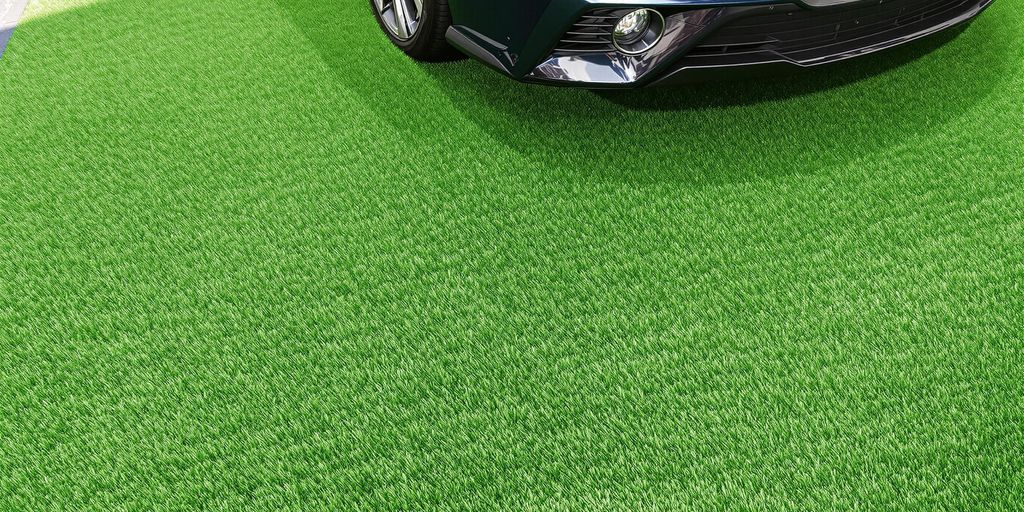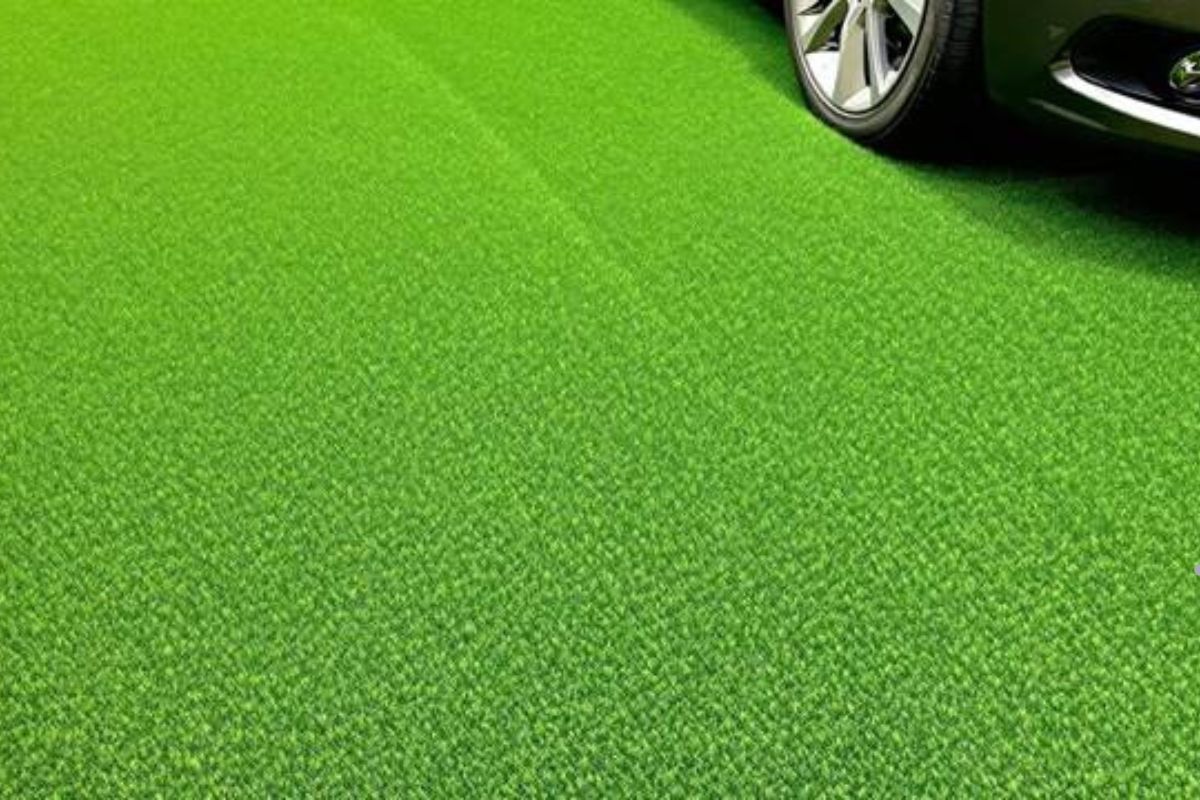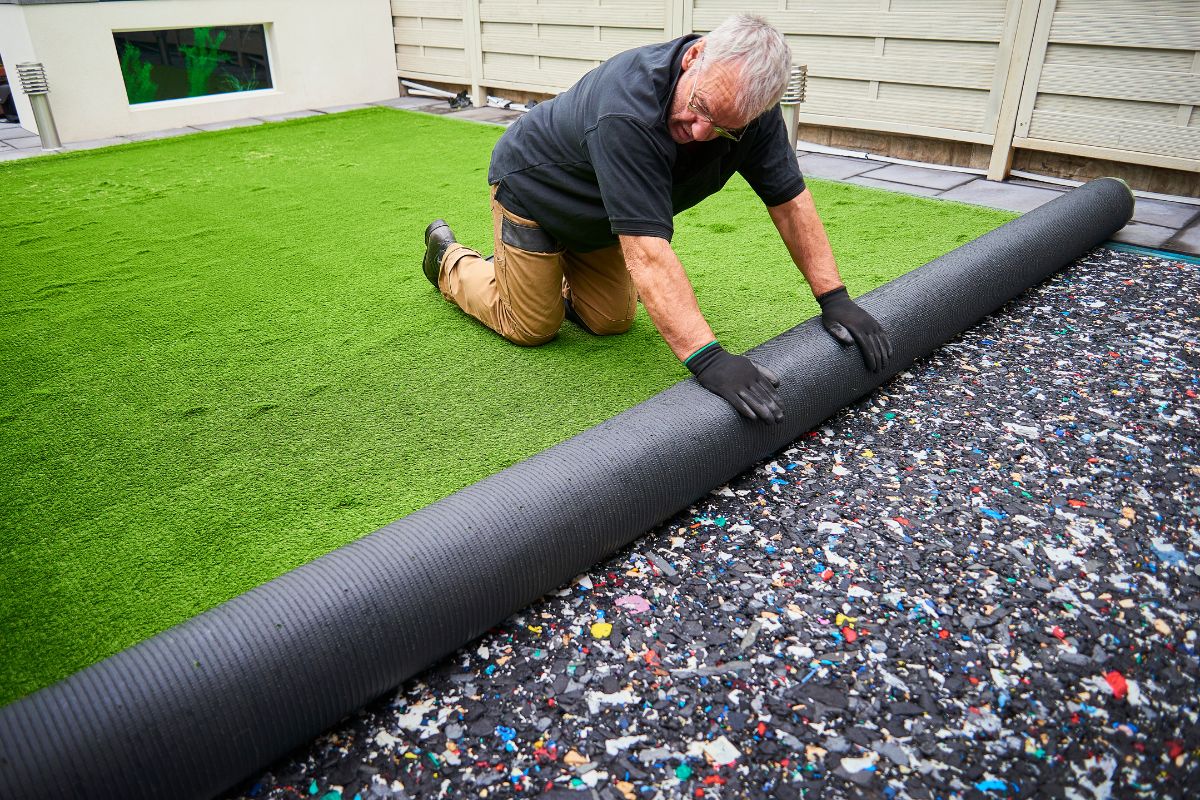
Driving on artificial turf might seem harmless, but it’s worth thinking about how it affects both your lawn and your car. From the makeup of synthetic grass to the wear it puts on your tires, there’s a lot to consider. Whether you’re parking temporarily or just curious, knowing the risks can save you from costly repairs later.
Key Takeaways
- Artificial turf is made to imitate real grass but has limits in handling heavy loads like cars.
- Driving on turf can leave tire marks, damage the fibers, and even cause uneven spots.
- Your car may experience extra tire wear or overheating due to the synthetic surface.
- Using mats or boards can help protect your turf if driving on it is unavoidable.
- Exploring alternative parking options can save both your lawn and vehicle from unnecessary damage.
Understanding Artificial Turf and Its Composition
What Is Artificial Turf Made Of?
Artificial turf is a synthetic surface designed to replicate the appearance and feel of natural grass. It’s typically made of a combination of polyethylene, polypropylene, or nylon fibers. These materials are chosen for their durability and ability to withstand wear and tear. Beneath the fibers, there’s often a backing material that helps hold everything together, along with a layer of infill—usually sand, rubber, or a mix of both. The infill gives the turf its cushiony feel and helps the blades stand upright.
- Fibers: Polyethylene, polypropylene, or nylon
- Backing material: Often made of polyurethane or latex
- Infill: Sand, rubber, or a combination
How Artificial Turf Mimics Natural Grass
The design of artificial turf aims to closely imitate the look and feel of real grass. The fibers are cut to varying lengths and colors to mimic natural grass blades, while the infill provides a realistic texture underfoot. Some high-end turfs even include brown or tan fibers to simulate dead grass, adding to the natural appearance. Plus, advanced UV-resistant coatings ensure the turf doesn’t fade easily under sunlight.
Artificial turf has come a long way, and modern versions are surprisingly convincing to the eye and touch, making them a popular choice for lawns, sports fields, and even indoor spaces. Proper maintenance is key to preserving your artificial turf year-round. If you’re dealing with winter conditions, check out our Snow & Ice Service to keep your lawn safe and damage-free.
Durability and Lifespan of Artificial Turf
One of the biggest selling points of artificial turf is its durability. Unlike natural grass, it doesn’t get muddy, wilt in the sun, or die during droughts. Most artificial turfs are designed to last between 10 to 20 years, depending on the quality and how well it’s maintained. Regular cleaning and occasional brushing to redistribute the infill can help extend its lifespan.
- Lifespan: 10-20 years
- Maintenance: Cleaning and brushing
- Resistant to: Mud, drought, and heavy foot traffic
For a successful installation, it’s important to start with a solid foundation. A well-prepared base ensures the turf stays smooth and stable over time. Learn more about the importance of installing artificial turf with a proper base.
Can You Drive on Artificial Turf? Key Considerations

Weight Distribution and Its Effects
Driving on artificial turf depends a lot on how weight is distributed across your vehicle. Heavy vehicles or uneven weight distribution can compress the turf and even the base layer, leading to dents or uneven surfaces. For lighter cars, the pressure might not be as severe, but it’s still something to think about. If you’re driving over turf occasionally, it’s less likely to cause long-term issues, but repeated use? That’s a different story. Over time, the weight can compact the underlying materials, making repairs necessary.
Traction and Tire Marks on Turf
One thing you might notice is how tires interact with the turf. Synthetic grass doesn’t have the same grip as natural grass or pavement. Tires can leave marks, especially if the vehicle turns sharply or accelerates quickly. These marks might not always be permanent, but they can make your lawn look a bit rough. For the best results, avoid sudden movements like quick stops or tight turns when driving on turf.
Potential Damage to Turf Fibers
The fibers of artificial turf are designed to mimic grass, but they aren’t indestructible. Driving over them can bend or flatten the fibers, making the area look worn out. In some cases, these fibers might not spring back, especially if the turf is older or lower quality. Regularly driving on it could even tear the fibers, exposing the base layer underneath. If you want to keep your turf looking fresh, limit vehicle traffic to only when absolutely necessary.
Can You Drive on Artificial Turf? Exploring the Impact on Your Lawn and Vehicle. Learn how driving on synthetic grass can affect your lawn and tires. Have questions? Call us now for expert advice and tips on protecting your turf and vehicle
Artificial turf can handle a lot, but it’s not invincible. Occasional driving might be fine, but repeated use could lead to wear and tear that’s hard to fix.
For occasional use, synthetic grass is engineered to handle some pressure, making it suitable for light vehicle traffic. Driving on artificial turf carefully and sparingly can help prevent unnecessary damage.
Impact of Driving on Artificial Turf for Your Vehicle
Tire Wear and Tear on Synthetic Surfaces
Driving on artificial turf can lead to unexpected wear and tear on your tires. The synthetic surface doesn’t provide the same grip as asphalt or concrete, which means your tires may experience uneven pressure. Over time, this could lead to premature tread wear, especially if you frequently maneuver or brake on the turf. Tires are designed for hard surfaces, so driving on turf can feel unnatural for your vehicle.
Risk of Overheating Due to Friction
When you drive on artificial turf, the friction between your tires and the synthetic grass can generate more heat than usual. This is particularly concerning during hot weather, as the turf itself tends to retain heat. Overheated tires may lose some of their performance, affecting their longevity and safety. If you have to drive on artificial turf, it’s a good idea to limit your speed and avoid sudden stops to reduce friction.
How Artificial Turf Affects Vehicle Traction
Artificial turf doesn’t offer the same level of traction as traditional road surfaces, which can be a problem for vehicles. You might notice your car slipping slightly, especially if the turf is wet or has loose infill materials like rubber pellets. This reduced traction could make it harder to control your vehicle, particularly during sharp turns or quick maneuvers. While it’s not a dealbreaker for occasional driving, it’s something to keep in mind for your safety.
Driving or parking on synthetic turf can flatten the grass blades due to the weight of vehicles. To restore its natural appearance, it’s recommended to brush the turf using a stiff brush. Learn more about maintaining synthetic turf.
Get a lush, healthy lawn with our expert lawn care services! From mowing to fertilizing, we’ve got you covered. Call us today for a free quote and let’s make your yard the envy of the neighborhood
Protecting Your Artificial Turf From Vehicle Damage
Using Protective Mats or Boards
If you plan to drive or park on artificial turf, using protective mats or boards can make a big difference. These act as a barrier between your vehicle and the turf, distributing the weight more evenly and reducing the risk of fiber damage or compression. Think of it like giving your turf a shield—it’s a simple step that can prevent costly repairs.
Here’s how to use them effectively:
- Choose mats or boards designed for heavy-duty use.
- Ensure the surface is clean before placing them to avoid trapping dirt or debris.
- Place the mats under the tires or where the vehicle’s weight will be concentrated.
For specialized solutions, consider products designed to protect soft surfaces, which are made to handle vehicles without harming the underlying material.
Best Practices for Parking on Turf
Parking on artificial turf isn’t ideal, but if you must, there are a few things to keep in mind to minimize damage:
- Always park on dry turf to avoid creating ruts or indentations.
- Avoid sudden movements like sharp turns or quick braking that could tear or displace the turf.
- Check your tires for debris like rocks or sharp objects that might dig into the surface.
By following these tips, you’ll keep your turf looking fresh and avoid unnecessary wear and tear.
Repairing Minor Damage to Artificial Turf
Despite your best efforts, accidents happen. If your turf gets damaged, don’t panic—it’s usually fixable. Here’s a quick guide:
- Identify the damaged area and assess the severity.
- For small tears, use adhesive or turf tape to patch them up.
- If fibers are flattened, brush them back into place with a stiff broom.
Regular maintenance can go a long way in extending the life of your artificial turf, even after minor mishaps. A little effort now can save you a lot of hassle down the road.
Environmental and Maintenance Implications
Heat Retention and Its Effects on Turf
Artificial turf tends to absorb and retain heat, especially during hot weather. This can make the surface uncomfortably warm for people and pets. Prolonged exposure to high temperatures may also weaken the turf fibers over time. If you plan to drive on it, the heat generated by your vehicle’s tires can worsen this effect, potentially causing damage to the turf’s structure. Consider watering the turf beforehand to cool it down if driving is unavoidable.
Cleaning and Maintenance After Driving
Driving on artificial turf can leave behind dirt, oil, and tire marks. Cleaning these residues promptly is essential to maintain the turf’s appearance and longevity. Here’s a quick cleaning checklist:
- Sweep or vacuum any loose debris.
- Use mild soap and water to remove oil stains.
- Rinse thoroughly with a garden hose to ensure no cleaning products remain on the surface.
Regular maintenance not only keeps the turf looking fresh but also helps extend its lifespan.
Regular maintenance is key to keeping your lawn in top shape. If your artificial turf needs a refresh, check out our Yard Clean Up Services for professional care and maintenance.
Environmental Concerns of Driving on Turf
Driving on artificial turf might release small particles from the turf’s infill or fibers into the surrounding environment. These particles can potentially contain hazardous chemicals. Studies have raised questions about the safety of artificial turf materials, particularly in terms of their impact on soil and water quality. To minimize environmental risks, avoid repeated driving on the same spot and ensure proper disposal of any turf debris after maintenance.
While artificial turf is durable, treating it with care ensures it remains both functional and environmentally friendly for years to come.
Alternatives to Driving on Artificial Turf

Designated Parking Solutions
One of the easiest ways to avoid driving on artificial turf is to set up designated parking areas. These can be paved driveways, gravel spots, or even reinforced grass zones specifically designed to handle vehicle weight. Having a dedicated space for parking not only protects your turf but also keeps your vehicle safe from potential wear and tear. Think about marking these areas clearly to prevent any confusion for guests or family members.
Reinforced Turf Options
If driving on turf is unavoidable, consider investing in reinforced turf systems. These are specially designed with a strong base layer to handle heavier loads without damaging the surface. Reinforced turf combines the look of natural grass with the strength of a durable foundation, making it a practical choice for multi-use spaces. Keep in mind that this option might require a higher upfront cost but can save you repair expenses in the long run.
Using Gravel or Paved Areas Instead
Another straightforward solution is to use gravel or paved areas for driving and parking. Gravel is a budget-friendly option that allows for proper drainage and is less likely to cause damage to nearby artificial turf. Paved surfaces, on the other hand, offer a more permanent and low-maintenance solution. Whether you choose gravel or pavement, this approach ensures your artificial turf remains pristine and undisturbed.
Protecting your artificial turf doesn’t have to be complicated. By planning ahead and considering alternatives like reinforced systems or designated parking, you can enjoy a functional and attractive outdoor space without the worry of vehicle damage.
Wrapping It Up
So, can you drive on artificial turf? Well, technically, yes, but it’s probably not the best idea. It might seem like a quick solution for parking or turning around, but the damage to the turf and the potential wear on your tires just isn’t worth it. Plus, if you’ve spent good money on your lawn, why risk messing it up? At the end of the day, artificial grass is made for walking, playing, and looking nice—not for cars. If you’re in a pinch, maybe think about finding a different spot to park. Your lawn (and your wallet) will thank you later.
Frequently Asked Questions
What is artificial turf made of?
Artificial turf is usually made from plastic materials like polyethylene or polypropylene. These are designed to look and feel like real grass. The base often includes a layer of rubber or sand for support.
Can you drive a car on artificial turf without damaging it?
Driving on artificial turf can cause damage, especially if the car is heavy. The pressure from tires might flatten or tear the turf fibers, and sharp turns can leave marks.
Is it safe for your car to drive on synthetic grass?
Driving on artificial turf isn’t ideal for vehicles. The surface can cause extra wear on your tires, and the heat from friction might even harm the car’s undercarriage.
How can you protect artificial turf from car damage?
You can use protective mats or boards under the tires when parking on turf. This spreads the weight and helps prevent damage to the grass fibers.
Does driving on artificial turf harm the environment?
Driving on turf can make it harder to clean and maintain. It might also release tiny bits of plastic into the environment, which isn’t good for nature.
Are there better options than driving on artificial turf?
Yes, you can use paved areas, gravel, or reinforced grass designed for vehicles. These options are safer for both your car and the turf.
Transform your lawn into a lush, green paradise! Our expert lawn care services ensure a healthy, beautiful yard all year round. Contact us today for a free quote and let’s make your lawn the best on the block!
